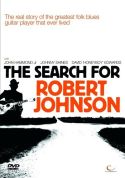DVD - The Search For Robert Johnson
|
"You can't hear a blues tune or a rock tune that don't have some of Robert's chords in it. Because he made them all." (Johnny Shines) Probably the most important man in delta blues history, but, other than the well documented myths surrounding the man, not that much appears to be really known about Johnson. So most people are likely to be intrigued when faced with a DVD with a premise like this one. But how does it measure up and how much do we actually get to know? Fronted by the blues singer John Hammond and produced by Chris Hunt, it certainly looks great. The atmospheric production, its leisurely pace and informal interviews draw you into the feel of the American South in a similar way that Johnson's music does. It's populated by both performers and local people who either worked with or knew him, many of whom hadn't spoken on camera before. There are also a number of remastered Johnson recordings featured, as well as specially recorded performances by the likes of Johnny Shines, David 'Honeyboy' Edwards and John Hammond himself. And then there is the real substance of the film - the interviews. As well as interviews with the aforementioned Honeyboy Edwards and Johnny Shines, blues historian Mack McCormack also contributes Johnson material for the first time on camera. More personal, and movingly, we also get to meet one of Johnson's girlfriends, Willie-Mae Powell, the inspiration behind 'Love In Vain'. If you watch the section where Willie-Mae hears the song and the 'Oh Willie-Mae' refrain for the first time and remain unmoved, check your pulse. It's also suggested that we finally get to see the place where Johnson played his last gig, courtesy of Honeyboy Edwards. Edwards claimed it was at a place called "Three Forks" just outside Greenwood, Mississippi, although all they found there was a bare patch of grass. A quick check at the Records Office proved that, before it was burnt to the ground in 1942, a grocery store had been sited there and juke joints were often found at the back of such stores. Edwards also "confirmed" how Johnson died, and we learn the reason for his death. I'm not sure how conclusive the film is. These recollections, although from key individuals who were certainly around at the time, are pulling memories from over 60 years ago and there are still inconsistencies in some of these first person accounts. The film also claims to have found the real Robert Johnson grave, which was at neither of the cemeteries that purport to hold his gravestone. In the end, how much you choose to believe is up to you. This is certainly a stronger document than any previous attempt to understand Johnson's life and the evidence is sourced from a series of first hand accounts, if potentially a little coloured by the tricks that memory can play. What is certainly true is that it's a very entertaining journey for anyone remotely interested in the history of the blues, perhaps more so than the musical legacy upon which it is based. July 2006
 |
|

Leave a comment